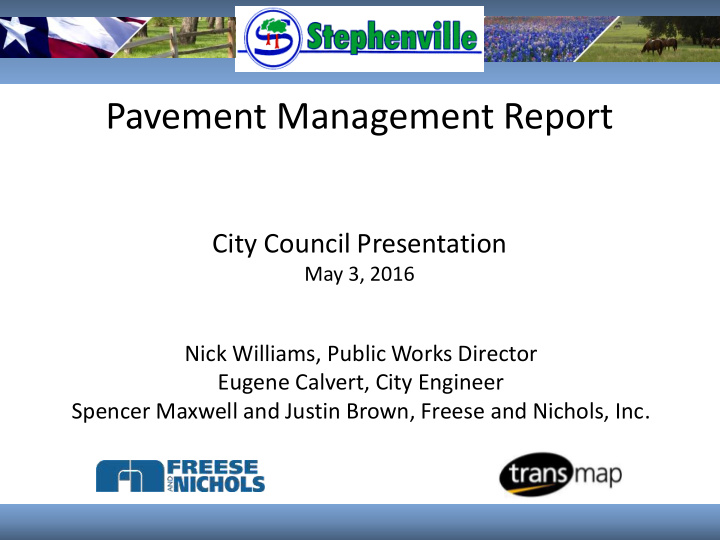



Pavement Management Report City Council Presentation May 3, 2016 Nick Williams, Public Works Director Eugene Calvert, City Engineer Spencer Maxwell and Justin Brown, Freese and Nichols, Inc. 1
Principles of Pavement Management Pavement Condition Index (PCI) • Standard procedure for rating the condition of a pavement network based on distresses • Developed by US Army Corps of Engineers • Provides a numerical rating on a scale of 0 to 100 2 2
Principles of Pavement Management 3 3
Pavement Data Collection Observed Distresses: • Alligator cracking • Longitudinal cracking Alligator cracking, potholes and utility cuts on S. 3 rd Ave. • Transverse cracking • Potholes • Repairs and utility patches • Raveling and weathering Longitudinal and transverse cracking on W. Oak St. 4 4
Pavement Data Analysis 5 5
Pavement Data Analysis Pavement % by # of Square Weighted Average # of Miles # of Square Yards Type Yards PCI Asphalt 80.2 1,132,522 91.9% 56 Concrete 4.2 56,710 4.6% 89 Brick 3.0 43,750 3.5% N/A Total 87.4 1,232,982 100% 58 6 6
Pavement Data Analysis MicroPAVER % of Network # of Weighted Avg. Functional Miles Square Yards by Sq. Yd. Sections PCI Class Code Code B 43 3.68 55,542 4.9% 73 Arterial Code C 130 11.47 158,958 14.0% 58 Collector Code E 751 65.05 918,022 81.1% 55 Local Total 924 80.20 1,132,522 56 7 7
Pavement Budget Scenarios Four budget scenarios, modeled over ten years: • Maintaining current funding level, what happens to PCI? • Decreases from 56 to 30 • Increasing funding to $1M per year, what happens to PCI? • Decreases from 56 to 41 • Budget required to maintain average PCI of 56: • $2.1M per year • Budget required to attain an average 71 PCI in ten years: • $3.2M per year 8 8
Pavement Budget Scenarios $3.2M $2.1M $1M $250k 9 9
Pavement Budget Scenarios $250k $1M $2.1M $3.2M 10 10
Brick Pavement Analysis • PCI standard methods do not address brick pavements • Each section scored as Good, Fair, and Poor • Primary distresses observed: Rutting, Displacement, Patching, Depressions Rating Distribution of Brick Pavement: 11 11
Brick Pavement Analysis West Green Street, rated “good” North Belknap Street, rated “poor” 12 12
Brick Pavement Analysis • Total estimated cost to improve all brick streets to “Good”: $1,070,000 • Consider designating brick street districts (downtown, near historic marker on Vanderbilt) • Consider reconstructing heavily traveled streets in poor condition with asphalt 13 13
Funding Strategies • General Tax Levy • Reallocation of Sales Tax Revenues • Transportation User Fees • General Obligation Bonds • Community Development Block Grants • Special Assessments • Franchise Utility Fees • Public Improvement Districts • City-County Interlocal Agreements • Utility Service Fees • Roadway Impact Fees 14 14
Recommendations • Maintain the database • Update PCI scores every three to five years • Apply engineering judgement to database recommendations • Make pavement maintenance a budget priority 15 15
Recommend
More recommend